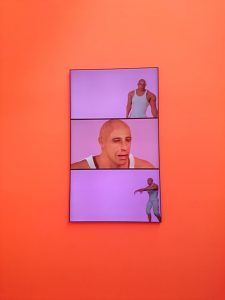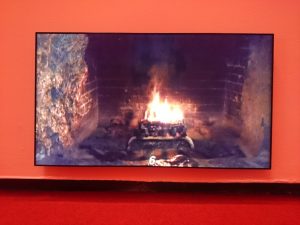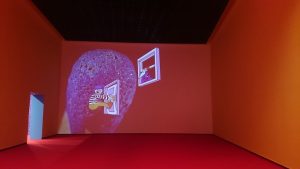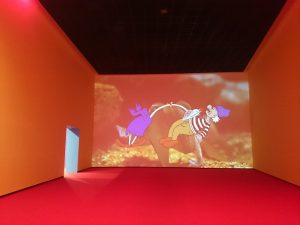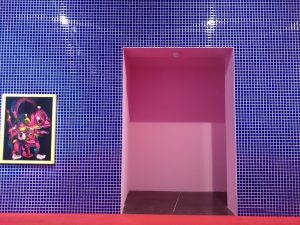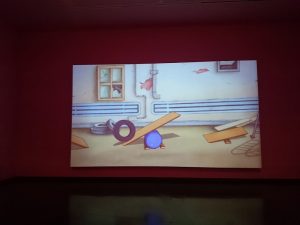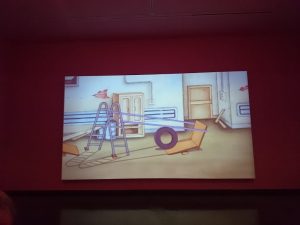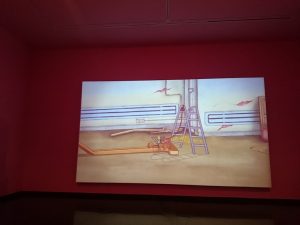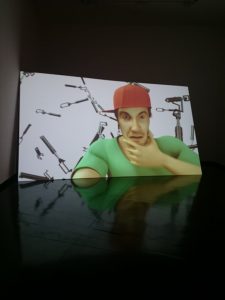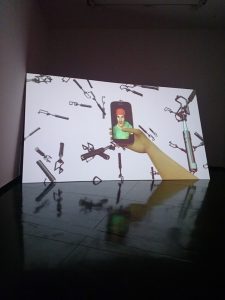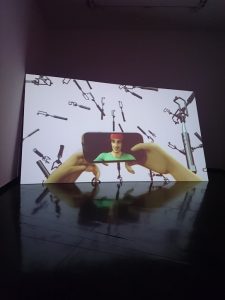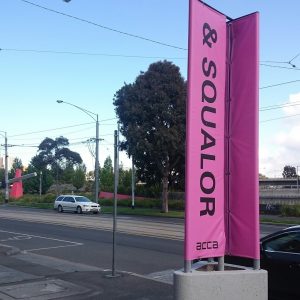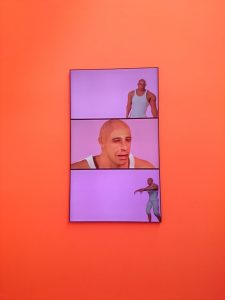《TV Moore: With Love & Squalor》@Australian Centre for Contemporary Art, Melbourne
– For English version please scroll down-
TV Moore的展覽《With Love & Squalor》在墨爾本的澳洲當代藝術中心舉辦,
這次的個展是TV Moore在墨爾本的首次個展,包含了新作和舊作。
在規劃墨爾本小旅行的時候就在網路上看到這個展覽了,馬上筆記下來!
這次的展是ACCA『澳洲年度藝術家』專案的其中一部份,同時也呈現了TV Moore最近的作品。
Australian Centre for Contemporary Art melbourne
Address – 111 Sturt St, Southbank VIC 3006
Phone – (03) 9697 9999
Period -15 AUGUST – 27 SEPTEMBER 2015
Official link – https://www.accaonline.org.au/exhibition/tv-moore-love-squalor
展覽作品
走進展廳看到的第一件作品,便是這次展覽作為主視覺設計的作品,《Vin-ish》。
▲ Vin-ish (2015)
這件作品是三頻道錄像。在最上面的畫面你看到的是一個帶著傻笑的男人,重複著無意識的動作;中間的頻道是同一個男人,但這次他留著眼淚,這次鏡頭並沒有帶到全身的樣貌,TV Moore選擇不凸顯他健美的身形,反而是停留在臉部,聚焦於他的脆弱和他的情感狀態;最下面的畫面則是他漫無目的的盲目遊走。
我想這某個程度上代表的是一種,人們不同的心理狀態和特質吧。
ACCA策展團隊的說法是這樣:
「這個角色是以美國演員Vin Diesel為雛型而設計的,以數位動畫的方式呈現,也因此帶有人造的、機械般的特質。飽滿的粉紅色背景襯托了Vin Diesel在流行文化中極具男性特質、同時也廣為大眾認識的個人象徵。」
好奇嗎?他長這樣囉。
ACCA這麼解釋:「結合了強烈的雄性特質與親暱的哭泣行為,藉此引發人們重新思考對性別的刻板印象。這件作品裡,Moore選擇的是大家很熟悉、而且具有強烈雄性特質的名人,但他想展現的,卻是他脆弱的一面。」Moore自己也說:「Vin Diesel一年多前在Youtube上放了這段影片,他那時候應該是滿興奮的,在那個情緒下,他錄了自己喝醉酒、笨拙地跳舞的樣子,他也不覺得這是什麼私密的影片,他就直接把它放上網路。他展現的那種脆弱真的很美。」
Moore其實也探討了「真實」和所謂的「人造」,他用我們現在常見的軟體虛擬出Vin Diesel這個人。數位科技的發達讓一切都變成可能,但到底有哪些是真實可靠的呢?館方也說了:「Moore在Vin的名字後面加了-ish(大概的、類似的)這個詞尾,讓我們更加懷疑自己眼前所見的這個Vin Diesel,是不是真的是Vin Diesel。」
▲ Existence (2009)
這件作品是2009年的舊作。
它給我的第一印象是,我覺得它很溫暖,畫面裡的壁爐讓我覺得很溫暖,橘紅色的背景也讓暖意增溫。作品擺在牆面的下方,就是現實生活裡壁爐會出現的位置,這樣的擺放方式讓作品看起來更真實。
在火焰之後,畫面出現了很多壯麗的山川、冰河,並且在每個小段落的最後,從10秒開始慢慢倒數。你會不自覺認真的跟著影片一起倒數,一起準備迎接下個不一樣的感官巡禮,可能是另一個風景,也可能是下一個循環播方的起點,重新回到溫暖的壁爐。10, 9, 8, 7, 6, 5, 4, 3, 2, 1.
在“Tripasso in Wackyland”裡,他結合了動畫和現成的電視節目內容或Youtube短片,例如一則報導或是一場籃球賽。你一方面會想看清楚背景節目的內容,一方面又想跟緊動畫的劇情,滿有趣的視覺經驗。
「這件作品其實挪用了Looney Tunes在1938年的小短片“Porky in Wackyland”,但Moore把主角換成繪畫大師畢卡索。你可以這樣解讀:畢卡索無助的困在自己的作品裡,不管多麼努力,他還是無法逃離自己。」
“Porky in Wackyland”的影片連結在這裡。
這個展間被漆成黃色和亮橘色,顏色飽和度很高,比前一個放置”Vin-ish”和“Existence”的展間更濃烈,(但照片可能有點看不出來)。策展人也在牆上投射了類似夕陽色調的光線,特殊的色彩和光線設定讓人感覺很溫暖,也讓人看作品看得更投入。
ACCA自己也說,其實空間裡面沒有放任何東西,但是光是這樣的色彩和光線,就能讓你覺得這個空間很滿。
▲ Photographic Paintings (2015)
這是一個布滿藍色方形磁磚的展間,地上鋪著大紅色絨毛地毯,天花板則是漆成飽滿的粉紅色,展場展示了四件超現實的攝影繪畫作品,分別是:《你》、《CCM》、《蛇洞》以及《夢想家》,都是2015年的作品。
這幾件作品採用的都是Cibachrome印刷技術(可以長久保留印刷品色彩鮮豔度)。Cibachrome其實是攝影作品印刷時常用的技術,根據某暗房工作室負責人Douglas Vincent的說法:「採用Cibachrome印刷技術的作品,表面非常光滑,尤其光從某些特定角度投射到作品上的時候,表面會非常的光亮;如果從比較側、比較斜的角度來欣賞作品,還可以看到金屬般的光澤哦。」
這幾件作品都是比較抽象的作品,有點表現主義的味道(?),藝術家根據自己心裡的感受來繪畫,表現自己心裡的狀態,所以沒有那麼的寫實。但還是可以辨別出某些明顯的東西啦,像是蛇的身體、眼睛等等。用色非常鮮艷,跟展間的氣氛搭配得很好。
特別的是,展場同時播放一件33分鐘的聲音作品《當貓夢到所有一切》,內容涵蓋許多Moore到處收集來的句子、網路文章、#網路熱門標籤等等,並用電腦模擬聲源唸出這些詞和句子。如果展場的設計換成比較灰暗、陰鬱的色彩,搭配一個狹小的展間,那這個電腦模擬聲就會顯得很詭異;但在這個明亮的展間裡,我其實不會太注意它的存在(也可能是因為我大腦有自動過濾英文系統,聽到英文的時候可以假裝什麼都沒聽到ㄏㄏㄏ)。但Moore想透過這件聲響作品探討的其實是,機器本身是不是能夠思考。在人工智慧這麼熱門的時代裡,這的確是滿值得思考的問題,也是許多藝術家著眼的重要議題囉。
通往下一個展間的小門一樣被漆成粉紅色,策展團隊也在門上打光,在下一個展間的牆上製造了陰影,這也暗示觀眾,下一個展間將會呈現不同的主題。
▲ The Way Things Grow (2014)
很喜歡這件動畫作品,裡面的各個小物件依靠著前一次旅程所得到的動力繼續滾動和前進,這個動力可能是地心引力、彈力,甚至是燃燒產生的熱能,他想到了各式各樣的能量形式,帶動整個畫面不停推進。沒人穿的鞋子慢慢走動、推動了木製輪子和汽車輪胎,有時又是紙捲、有時候是火焰,概念很簡單,但是透過這樣的方式表現,卻很有張力。
▲ Frat Self SUN SPACE (2015)
這件作品裡,你看到的是一個一直自拍的自戀男子,在壯麗的自然景觀前、在外太空….在每個不同的場景裡,他做的事情就只有自拍。背景有時會換成滿天漂浮的自拍棒,滿可愛的。
我很喜歡Moore的風格,以幽默或是戲謔的手法來說一些跟社會有關的議題或故事。即使站在美景前,有些人也只是找wifi、在臉書打卡,而不是多看一眼眼前那片美麗的風景。
結論
Moore的作品題材非常廣泛,有藝術史裡的明星藝術家,也有當代的電影名人。善用各種視覺語言衝擊觀者的感官以及思維,卻又讓作品充滿趣味,也許這就是他受歡迎的原因吧!
他在一段The Creators Project為他做的專訪裡提到:「我覺得有時候『視覺藝術』其實並不那麼『視覺』,很多時候那其實都是創作者靠著想像和直覺所創造出來的世界。」
「其實這次展覽我想說的是,科技是非常多元化的,可以很私密、也可以很公開的,可以很脆弱、很甜美,也可以很怪。我想這就是它有趣的地方吧。」
林庭如,2015年11月寫於澳洲坎培拉
– ENGLISH VERSION BEGINS HERE-
TV Moore: With Love & Squalor@Australian Centre for Contemporary Art, Melbourne
This is his first solo exhibition in Melbourne. “With Love & Squalor is part of ACCA’s annual Influential Australian Artist program, and brings together a combination of TV Moore’s recent and new works,” says ACCA.
When I was planning my trip for the study break, I saw this exhibition and highlighted it in my notebook right away!
Australian Centre for Contemporary Art melbourne
Address – 111 Sturt St, Southbank VIC 3006
Phone – (03) 9697 9999
Period -15 AUGUST – 27 SEPTEMBER 2015
Official link – https://www.accaonline.org.au/exhibition/tv-moore-love-squalor
When we entered the gallery I was attracted by the key vision artwork, Vin-ish (2015).
This is a three-channel video. On the top one you saw a man with silly smile and does some unconscious movements. The second one, you found the same guy but he’s tearing for some reason. The lens focus on his facial expression instead of the whole body, ignoring his robust body and put emphasis on his vulnerabilities instead. And the last one, this guy wonders around numbly and scrambly.
I think this kind of reflects the different characteristics and status of mind of people.
According to the curatorial team,
“the central figure appears to be modeled on Vin Diesel the American actor, but being digitally animated, the figure has an artificial or machine-like quality. With a lush pink backdrop, Vin-ish resents an intimate encounter with a highly recognisable masculine figure in pop culture.”
Curious? Ok this is how he looks like.
As ACCA said, “The pairing of a masculine icon with the intimate act of crying questions gender stereotypes. In this work Moore takes a hyper-masculine figure from the media that most of us would be familiar with, and makes him vulnerable.” Moore himself stated, “He(Vin Diesel) YouTubed this video a year or so ago where he was on ecstasy or something, and it’s this delicate moment where he chose to film himself dancing, awkwardly and drunk. Instead of private he went public—he doesn’t care—and it was a vulnerable, beautiful thing.”
Moore also discusses the real and artificial characters/stuffs in the world through this piece of work. He made the avatar for Vin Diesel through the advanced software we can easily access to nowadays. Thanks to the digital technology, we can made every image possible, but is it really authentic and reliable? “By adding –ish to Vin, Moore adds an element of doubt to whether this figure is actually Vin Diesel,” commented by ACCA.
▲ Existence (2009)
So this one is an older piece from 2009, six years ago.
For me the first impression is, I felt warm when I came closer to the fire place. The bachground wall is red, which reinforces the sense of warm again. And this piece was put at lower position that similar to where a fireplace would really be. That’s why it is somehow so real.
Following by the flames, we found marvelous scenery like mountains and glacier in this video, and you would somehow follow his instructions in the video to count down and to prepare yourself for the next different settings in the film. 10, 9, 8, 7, 6, 5, 4, 3, 2, 1. Change.
▲ Tripasso in Wackyland (2014)
In “Tripasso in Wackyland,” he combines those ready-made TV and Youtube footage with his animation, for example, a broadcast for basketball game. On one hand you tried hard to see the scenery behind the illustrated animation, on the other hand you wanted to know the story line for it. Quite an interesting experience.
“The work is a reference to and appropriation of the Looney Tunes
short film ‘Porky in Wackyland’ from 1938, but Moore has replaced Porky Pig
with Pablo Picasso, “ ACCA stated, “this video can be seen as a portrait of Picasso haunted by his own artwork, and running away from his own self.”
ps. Link for “Porky in Wackyland” is provided here.
The room was colored yellow and orange, even it’s not so obvious in my photos, they are actually more saturated than the previous room where “Vin-ish” and “Existence” located. Moreover, there’s “a sunset-like glow” on the wall, both making me feel warmer and engaged.
“Although there is actually nothing physical in the space, the gallery feels completely full.” (-ACCA)
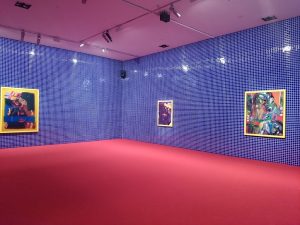
▲ Photographic Paintings (2015)
With four surrealism works, the curator decorated the room with blue square tiles, red rug, and pink ceilings. All the four photographic paintings in this room, “You,” “CCM,” “Snake Pit,” and “The Dreamer,” were produced in 2015 and painted on cibachrome.
The suface of cibachrome “is exceptionally smooth giving prints a high gloss finish with light reflectance that is somewhat directional — viewed at oblique angles, prints can have an almost metallic appearance.” (According to a darkroom studio owner Douglas Vincent.)
The topic in these four pieces are not so recognizable. You may think that they are a bit expressionism, which artists create works based on their internal status instead of objective perception to the world. However, you can still identify some obvious characteristics in the paintings, such as the body and eyes for the snake. Colours of these four pieces are very prominent, matching the atmosphere in this room pretty well.
Another work in this room is a sound work called “When Cats Dream of Everything,” which is composed of a variety of phrases, twitter poems, hashtags, etc. That is a computerized sound produced by Moore. What he wants his audience to think about is, can machine think or have emotion? I reckon this is an interesting topic especially in this generation which Artificial Intelligence is a hot thing. You can also figure a list of artists focus on this issue to create their own artworks.
Before entering the next room, the curator put a pink gate and used the light to cast shadow on the wall behind the gate, giving us a hint that they are about to change the theme for the next room.
▲ The Way Things Grow (2014)
“The Way Things Grow” (2014)
I like this animation a lot. Those little things keep moving on by energy they’ve got in previous journey, such as gravity, bouncing, or even thermal energy. Starting with a walking shoes which no one wears on, and then pushing the wooden wheels and tires, sometimes there’s a paper roll, sometimes flames… The concept in this work is pretty simple, but the way he expresses is quite interesting and impressive.
▲ Frat Self SUN SPACE (2015)
In this work, you will see a guy keeps doing selfies in different scenes, from brilliant natural landscapes to the outer space. Yet sometimes behind him there are many many selfie sticks floating in the background.
I really like the style Moore creates. He uses a humorous way to tell stories, and leads us to think about social phenomenon. Even standing in front of the sublime landscapes, the only thing you do is checking wifi access and checking-in on Facebook without a second glimpse on marvelous scenes.
CONCLUSION
Say, TV Moore created many art pieces based on a variety of references. From art history famous star to celebrity in contemporary era. He utilises multiple visual languages to collide with your senses and thoughts. You can find lots of fun appreciating his works. I guess this is why he’s popular.
I was impressed by TV Moore’s words in his interview made by The Creators Project. “I think art sometimes loses the fact that it is visual art, and imagination and intuition is a huge part of it.”
Also in the same interview he stated, “This show is speaking to the fact that technology can be private and public at the same time, and vulnerable and sweet and soft and weird. I think it’s an interesting place that we’re at.”
NOTE
The ACCA comments were written and compiled by Georgina Glanville, Artist Educator and Alyce Neal, Casual Educator, ACCA.
Lin Ting-Ru
finished in Canberra, Australia. Nov 2015

